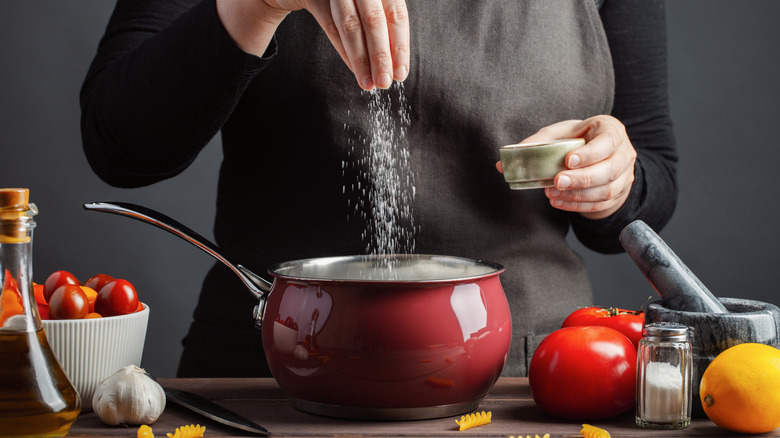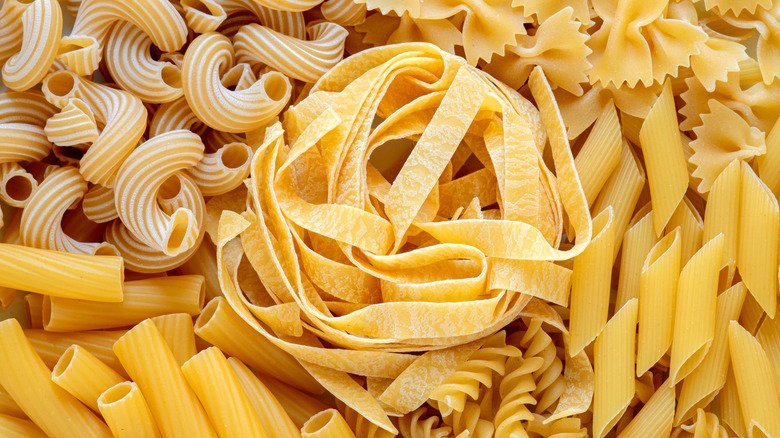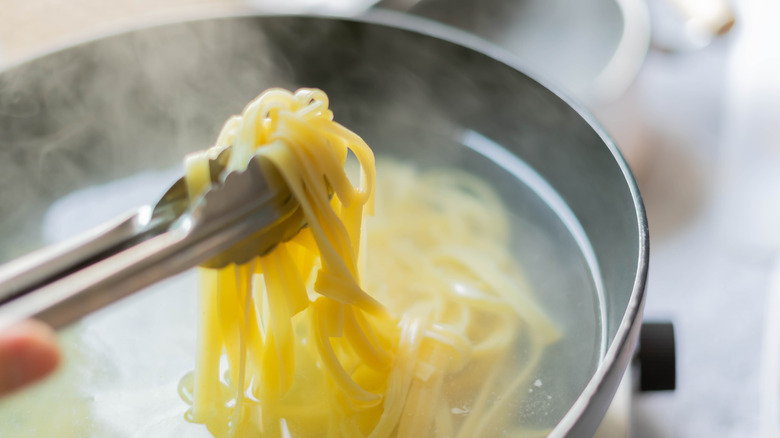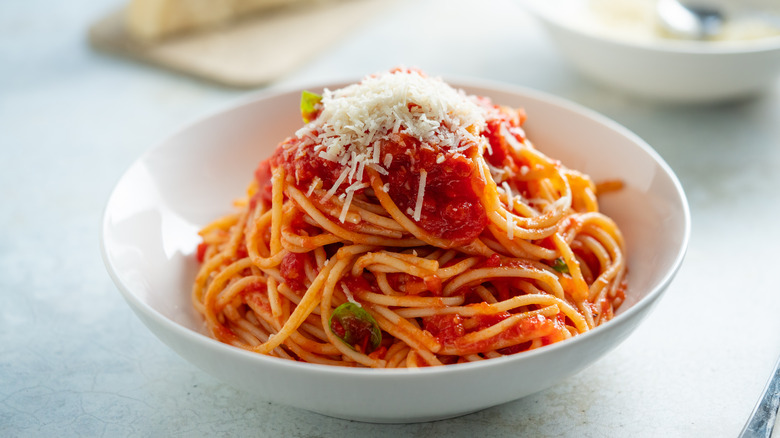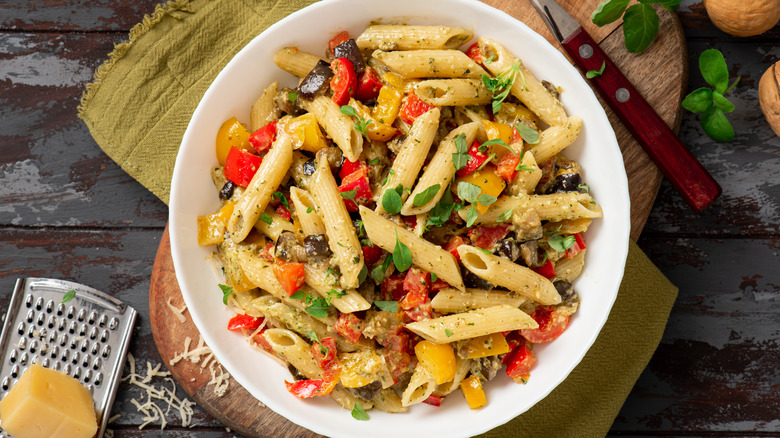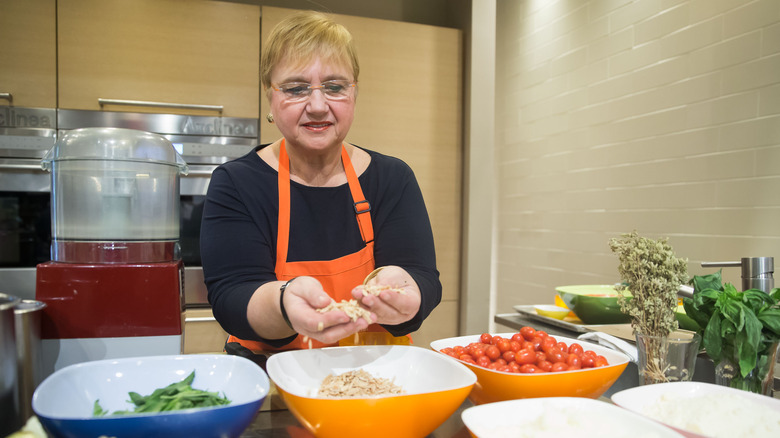The Best Tips For Cooking Pasta, According To Lidia Bastianich
Lidia Bastianich is a beloved chef, restaurateur, and television personality. She is the owner of multiple successful restaurants, including Felidia and Del Posto in New York City. And perhaps most famously, she's the host and creator of PBS's "Lidia's Kitchen," a show in which she shares her passion for Italian cooking via helpful tips and recipes. Born in Pula, Croatia, Bastianich immigrated to the United States as a young girl and learned to cook from her mother and grandmother.
There might be a few things you didn't know about Bastianich, but the thing she's most famous for is her authentic Italian cooking style and her dedication to using fresh, high-quality ingredients. She has received numerous accolades for her work in the culinary world, including multiple James Beard Awards. So, who better than Lidia Bastianich to teach us about the best way to cook pasta? Learn how to make perfect pasta, every time.
Use lots of water, well-salted
Bastianich stresses that one thing that can make or break a good pasta dish is the amount of salt you use. It's important to strike the right balance, as too little salt can make the pasta taste bland, while too much can make it inedible. So, how much salt should you put in the water when cooking pasta?
The general rule of thumb is to use about 1 tablespoon of salt for every 4 quarts of water. This works out to be about 1 teaspoon of salt per quart of water, or half a teaspoon of salt per pint of water. Keep in mind that this is just a guideline, and you may need to adjust the amount of salt based on your personal taste preferences and the type of sauce you're pairing with the pasta. The type of salt you use makes a difference: You might need to use more coarse sea salt or kosher salt than table salt to get the same amount of seasoning.
When you salt the water also matters, advises America's Test Kitchen. It's best to add salt to the water before you add the pasta. This allows the salt to dissolve and evenly distribute throughout the water, seasoning the pasta as it cooks. If you add the salt after the pasta is already cooking, it can be difficult to evenly distribute and may result in uneven seasoning.
Choose the best pasta for your recipe
While it's easy to grab any old box of pasta from the grocery store shelves and assume it will work in any recipe, it's actually important to choose the right type of pasta for the dish you're making.
One factor to consider is the shape of the pasta. Different pasta shapes are better suited to different sauces and dishes. For example, long, thin noodles like spaghetti or linguine are best for lighter sauces like marinara or carbonara, while shorter, thicker noodles like penne or rigatoni work well with heavier, chunkier sauces like bolognese. Delicate noodles like capellini or angel hair are best for broth-based soups or delicate seafood dishes, while thicker noodles like fettuccine or pappardelle are better for cream- or cheese-based sauces.
Another factor to consider is the type of pasta. Most pasta is made from wheat flour and water, but there are also varieties made from other grains like corn, rice, or quinoa. These alternative kinds of pasta may be a good choice for people with dietary restrictions or who are looking for a healthier option. Additionally, there are fresh pasta options, which are made from eggs and flour and tend to have a softer, more delicate texture than dried pasta. These are best used in dishes where the pasta is the star of the show, rather than being drowned in sauce. Of course, Chef Bastianich has her favorite type, which she shared with Wisconsin Public Radio: "Make sure that it's made from 100% semolina flour ... because it has more proteins, more gluten in it."
Never add oil to the pasta water
Many home cooks have heard the advice to add a little bit of oil to the water when cooking pasta to keep it from sticking together. However, this is actually a myth and Bastianich is clear about her thoughts on the practice, as she told Smithsonian Magazine: "Do not — I repeat, do not — add oil to your pasta cooking water! And that's an order!" But why not, Chef Bastianich?
First and foremost, oil and water don't mix. While the oil may coat the individual strands of pasta initially, it will eventually separate and pool at the bottom of the pot. This can actually make the pasta stickier, as the oil can coat the starch on the surface of the noodles and prevent them from separating as they cook. Second, adding oil to the pasta water can prevent the sauce from sticking to the noodles. When you drain the pasta, the oil will rinse off, taking any flavorful starch with it. This can result in bland, unappealing pasta that doesn't hold onto the sauce as well.
Finally, adding oil to the pasta water is just unnecessary. As long as you use a large enough pot of boiling, salted water, the pasta should cook evenly and not stick together. Simply stirring the pasta occasionally as it cooks can help prevent any sticking.
Don't serve pasta on a plate
When it comes to serving pasta, many people automatically reach for a plate. However, there are a few reasons why serving pasta in a bowl instead of on a plate can be a better choice, and one that Lidia Bastianich heartily recommends for several reasons.
Bowls are more conducive to twirling long noodles like spaghetti or linguine. It can be difficult to twirl a fork full of noodles on a flat plate, leading to tangled or broken noodles and a less enjoyable dining experience. A bowl, on the other hand, allows you to easily twirl the noodles around your fork and get a satisfying bite every time. Bowls are also better at retaining heat. Pasta can quickly become cold and unappealing when served on a plate, especially if it's a dish with a lot of sauce. To keep your pasta dish piping hot, Chef Bastianich recommends preheating the bowl and arranging your pasta in an abundant-looking mound, according to Go-Wine.
Finally, bowls can be more visually appealing. Placing a heaping portion of pasta in a bowl can create a more inviting presentation, especially if you're serving a creamy or saucy dish.
Use the pasta cooking water in your sauce
When it comes to making a flavorful pasta sauce, it's important to use every ingredient to its full potential. One trick that many professional chefs, including Bastianich, use is incorporating some of the pasta cooking water into the sauce. "It acts as a medium to extract and blend the seasonings and sauce ingredients," notes Bastianich via Business Insider. Pasta cooking water is full of starch. As the pasta cooks, some of the starch from the noodles leaches out into the water. This starch can help to thicken and enrich the sauce, giving it a creamy, velvety texture.
Another bonus is that pasta cooking water is already seasoned. When you add salt to the water before cooking the pasta, it helps to season the noodles from the inside out. This means that the pasta cooking water already has some flavor, and adding it to the sauce can help to enhance the overall flavor of the dish.
To use pasta cooking water in a sauce, simply ladle out about half a cup of the water from the pot after you've drained the pasta. Be sure to taste the water first to make sure it's not overly salty, as this can throw off the balance of the sauce. Then, add the water to the sauce and stir to combine. You may need to adjust the seasoning of the sauce slightly, but the pasta cooking water should help to enhance the flavor.
Test the pasta for doneness
Pasta is a staple in many households, but it can be tricky to get it just right. Undercooked pasta can be hard and chewy, while overcooked pasta can become mushy and gummy. So, how can you tell when your pasta is perfectly cooked? "There's an old saying in Italy, 'If you throw the pasta to the wall, and it sticks, it's done,'" Chef Bastianich advises, via WPR. However, if you want to know whether your pasta is al dente without throwing it around your kitchen, there are a few other tricks to try.
The best way to test the pasta for doneness is to taste it. The pasta should be tender but still have a little bit of a bite. If it's too hard or crunchy, it needs to cook a little longer. If it's too soft or mushy, it's overcooked. Another way is to look at the pasta. Pasta should be cooked through, but not mushy or falling apart. If the pasta looks undercooked or raw, it needs to cook a little longer. If it's falling apart or breaking easily, it's overcooked.
Don't rinse the pasta
It's a common misconception that rinsing pasta after it's been cooked will help to prevent it from sticking together or becoming mushy. However, there are actually a few reasons why you shouldn't rinse pasta after cooking it.
Most importantly, rinsing pasta removes some of the starch that helps the sauce stick to the noodles. This can result in bland, unappealing pasta that doesn't hold onto the sauce as well. Additionally, rinsing the pasta can wash away some of the flavor and nutrients that are absorbed during the cooking process. Rinsing pasta can also make it more likely to stick together. When you rinse pasta, you remove some of the starch that helps to keep the noodles separate. This can cause the pasta to clump together, especially if it's not served immediately after cooking.
Finally, rinsing pasta can lower the temperature of the noodles, making them less appealing when served. Hot, freshly cooked pasta is more flavorful and enjoyable than lukewarm pasta that has been rinsed and cooled down. Even for a dish that's served cold, such as a pasta salad, Bastianich stresses that you shouldn't rinse the pasta (via YouTube.) Instead, to chill pasta for a pasta salad, you should toss a few ice cubes with the cooked pasta to help cool it down.
Keeping these tips from a renowned, beloved chef in mind will help you achieve pasta success every time, and your dishes will be even more flavorful.

